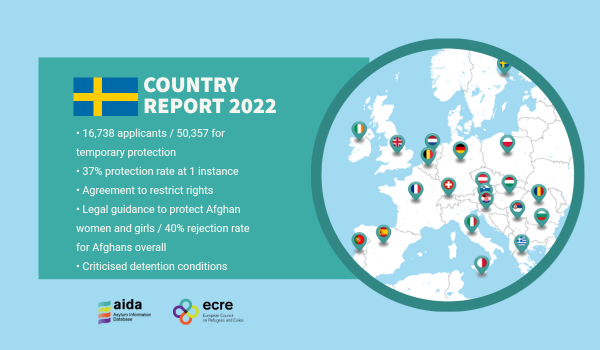The updated AIDA Country Report on Sweden provides a detailed overview on legislative and practice-related developments in asylum procedures, reception conditions, detention of asylum seekers, content of international protection as well as procedure for and content of temporary protection in 2022.
Throughout 2022, Swedish authorities saw 16,738 applications for international protection lodged before them, an increase of 48% compared to 2021, slightly the EU-wide increase of over 50%. The most represented nationalities amongst asylum applicants were Afghanistan, Ukraine, Syria and Iraq. The overall recognition rate increased slightly to reach 37%, compared to 32% in 2021.
Concurrently, the Swedish Migration Agency registered 50,357 applications for temporary protection in 2022. Of those tried on the merits (47,310), 100% were granted a residence permit. After initially limiting the scope of TPD to those eligible under the EU Council Decision, the Swedish Government decided to expand the scope to also include eligible persons who entered Sweden up until 30 October 2021.
The country’s general elections brought about the Government platform agreement or Tidö agreement, an agreement between the parties forming the new government of October 2022 and the Sweden Democrats. The agreement announces many changes, including a review of the asylum process, to enhance quality, consistency and legal certainty; a review of the existing regulation on safe countries of origin to expand the list to countries where parts of it can be considered safe, as well as a shift in responsibility for the drawing up of the safe countries list from the Migration Agency to Government offices. The agreement moreover seeks to limit rights of asylum seekers in the context of reception to the minimum level in line with international law, including by ending the possibility for asylum seekers to choose and arrange their own accommodation in favour of transit centres. Lastly, the Tidö agreement suggests new conditions to quality for Swedish citizenship and announces an inquiry to provide further restrictions and conditions for family reunification. However, there have been no formal legislative changes yet.
Regarding the situation in Afghanistan, the Swedish Migration Agency published new legal guidance in December 2022, in which it assessed that the situation of women and girls in Afghanistan was so severe that they should be in general regarded as refugees. Overall in 2022 the recognition rate for Afghan nationals was 60%.
Detention conditions were criticised both at the national and international level. The UN Working Group on Arbitrary Detention expressed serious concerns as to allegations of lack of appropriate treatment regarding a detainee’s health condition, recalling that all detained persons are to be treated with humanity. The Parliamentary Ombudsman in turn highlighted concerns about inter alia seclusion of detainees, around-the-clock camera surveillance of secluded detainees, personal information of detainees being left in view of other detainees.
As regards family reunification, the Migration Court of Appeal aligned its position with that of the CJEU of July 2020 the relevant time for determining the age of the applicant or the sponsor in the case of (former) minors. The SMA also issued a legal position in line with these judicial assessments. In October 2022, the European Court of Human Rights found that in the case at hand, Sweden’s restrictions on the right to family reunification of subsidiary protection beneficiaries, specifically the 3-year waiting period, did not breach the European Convention on Human Rights.
For further information:
- Find comparative information in the Asylum Information Database (AIDA) managed by ECRE

